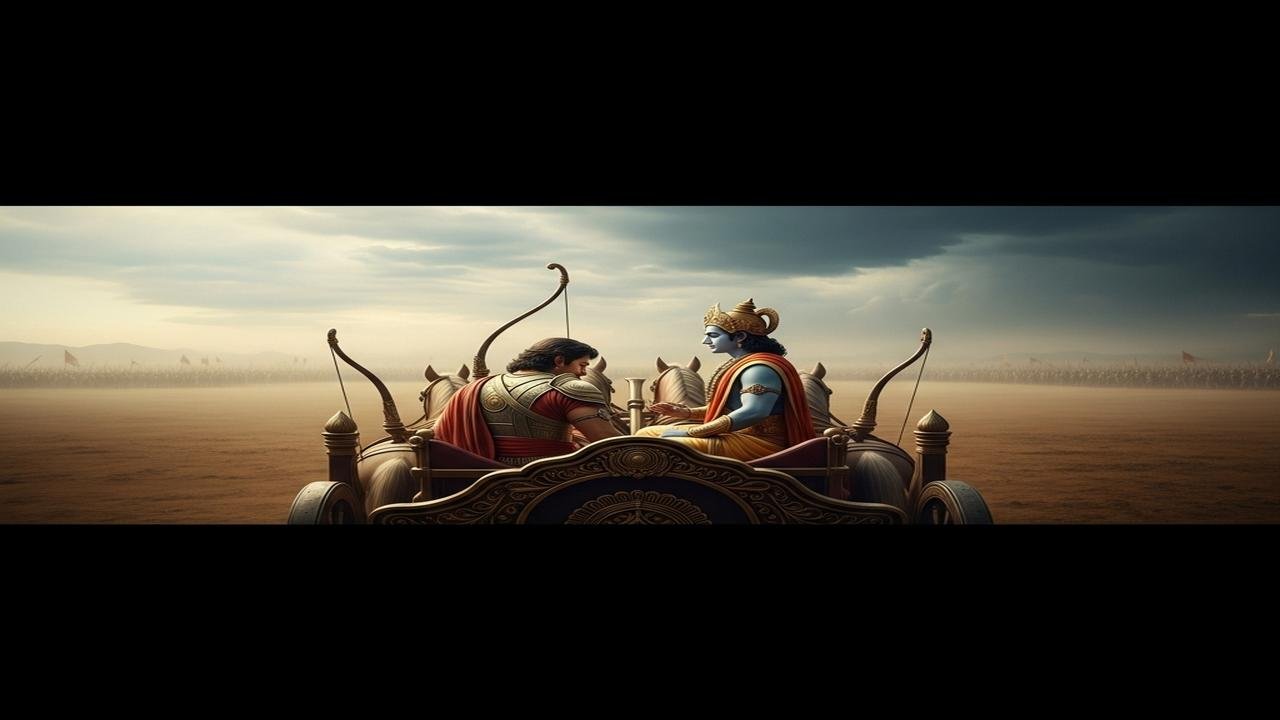Arjuna At Kurukshetra Why He Refused To Kill Bhishma

Context: Arjuna’s crisis on the battlefield
The episode appears in the Mahabharata’s Bhishma Parva and is condensed in the Bhagavad Gita as its opening chapter, commonly called Arjuna-vishada-yoga — the yoga of Arjuna’s dejection. Arjuna, the Pandava warrior, stands on the Kurukshetra plain opposite relatives, teachers and elders. Before the fighting begins he tells Krishna he cannot raise his bow: his limbs tremble, his mouth goes dry, and his resolve collapses. The heart of his objection is a moral and emotional refusal to kill certain people in his own family and social order.
What Arjuna says he fears
- Killing teachers (guru) — He names respected elders and instructors among the Kaurava side, most notably Bhishma and Drona in the epic narrative. In traditional Indian culture the guru (teacher) holds sacral status; to slay a guru would be a deep breach of ethical and religious norms.
- Destroying family and kin — Arjuna imagines the long-term consequences: children orphaned, family lines broken, and social disorder when righteous duties of offspring and householders are disrupted.
- Committing sin (papa) and losing reputation — He worries about the karmic consequences and the stain on his own honor if he kills elders and elders’ descendants.
- Social collapse — He foresees that the destruction of families will lead to societal decline: loss of tradition, observances, and the regular functioning of sacrificial and domestic duties.
How Arjuna expresses these fears
In the Gita’s opening verses he literally describes physical weakness — his bow falling from his hand, his body trembling — and then lays out ethical reasons why he cannot fight. The tone is not merely tactical or cowardly; it is a moral appeal rooted in the social and religious world he inhabits.
Why killing teachers and elders is specially fraught
Across many Hindu traditions, the teacher-disciple relationship is sacralized. The guru is a link to scriptural knowledge, ritual authority and lineage continuity. In dharmashastra literature and ritual manuals, killing one’s teacher or elder is treated as a grave violation that risks ritual impurity and social rupture.
- Legal-ethical status: Classical texts distinguish between obligations to one’s varna-duty (svadharma) and duties arising from household and lineage; harming elders cuts into both.
- Psychological and social weight: Elders embody memory and continuity; killing them is experienced as killing the past and the norms that sustain a community.
How commentarial traditions read Arjuna’s fear
Commentators and schools interpret Arjuna’s reluctance in different ways, often reflecting their wider philosophical stances.
- Advaita Vedanta readings — Shankara and later Advaita readers treat Arjuna’s despair as an ordinary human confusion arising from attachment and ignorance. The remedy, on this reading, is knowledge of the self (atman)—a recognition that the true Self is beyond birth and death reduces moral panic about physical killing.
- Vaishnava readings — Many Vaishnava commentators stress surrender to Krishna. Arjuna’s hesitation becomes the prelude to soulful surrender and practical instruction in karma-yoga (action without attachment) and devotion.
- Dharmashastra and ritual-focused readings — These emphasize the competing duties at stake: a kshatriya’s (warrior’s) duty to fight versus obligations to family and respect for elders. The emphasis is on resolving those norms rather than annulment of duty.
- Modern scholarly perspectives — Some historians and textual critics read Arjuna’s reluctance as a narrative device that opens space for ethical debate within the epic or as reflecting historical tensions about war, politics and kinship.
Krishna’s response and its implications
Krishna’s reply — the core teaching of the Gita — reframes the situation: he emphasizes impermanence of the body, the eternal nature of the true self, and the necessity for Arjuna to perform his dharma — his role as a kshatriya. Krishna introduces central doctrines such as duty without attachment, the distinction between action and fruit, and the vision of a broader cosmic order that can justify painful choices.
Different traditions take different aspects of Krishna’s counsel as decisive: some prioritise the metaphysical reassessment (the imperishability of the Self), others the ethical discipline of detached action, and some the devotional surrender that legitimises acting in accordance with divine will.
Interpretive tensions and contemporary resonance
The episode refuses a single, comfortable reading.
- For some readers Arjuna’s fear is an ethical intuition to be respected — a voice of human compassion objecting to kin-slaughter.
- For others it is a moral confusion born of attachment and limited vision, requiring philosophical correction.
- Scholars and devotional traditions alike continue to debate whether Krishna’s teaching vindicates violence in service of duty or reframes duty so that violence must be reimagined within a larger spiritual discipline.
What this episode invites us to consider
At its core the scene asks how a person ought to act when duties conflict and when violence threatens those we love and revere. It probes the limits of role-based obligations (svadharma), the sanctity of the teacher-student bond, and the psychological weight of moral injury.
Across centuries, the episode has been a resource for spiritual teaching, ethical debate, and political argument. It continues to prompt careful reading — and respectful disagreement — among Śaiva, Vaiṣṇava, Śākta, Smārta, and modern interpreters.
Closing note
The story gives no easy answers, but it does model a type of moral seriousness: a warrior who halts not out of cowardice but because he feels the full force of normative conflict. How later readers adjudicate that conflict depends on theological, philosophical and historical commitments — and many continue to find in the exchange between Arjuna and Krishna a lasting provocation to think seriously about duty, violence and conscience.
